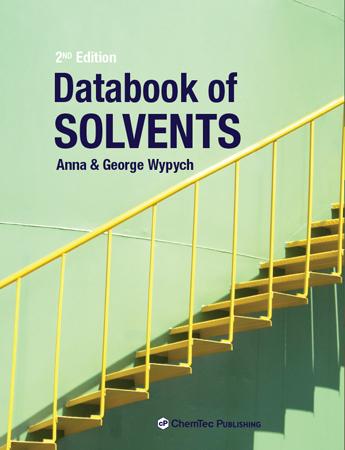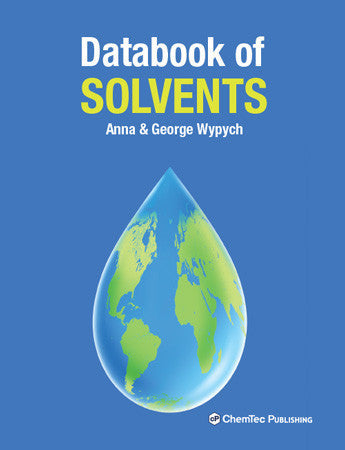The second edition of this book was redesigned to include all high production volume solvents. The high production volume solvents are produced or imported at levels greater than 1,000 tones per year in at least one member country. The most recent list of these chemicals has been compiled based on submissions from eight member countries (including the USA) in addition to the European Union’s HPV list according to EC Regulation 793/93. It has been used by the member countries to choose chemicals on which to make a hazard assessment for human health and the environment.
This selection of data is important considering that it is expected that the total amount of solvents to be used in 2020 in the USA alone will be 4.3 million tons. Still, an unknown but considered a large fraction of these massive amounts of solvents ends up polluting the air, water, and soil. It is hoped that this the most extensive and up-to-date information on these solvents (sometimes containing suggestions on safer replacements if they were readily available) will help in a more rational, effective, and safe use of the solvents.
This book is the reference source containing a large number of data on the most important solvents used in industry. Solvents comprise a large group of commercial products of different purities determined by their application (e.g., chemical reagents, pharmaceutical solvents, cleaning liquids, etc.). Their properties are very important for selection of solvents for the application. They are also needed to understand the behavior of solvent mixtures.
This book contains a large set of data on the most important solvents used in everyday industrial practice. The Databook of Solvents provides information divided into five sections: General, Physical, Health, Environmental, and Use.
In the General section the following data are displayed: Name, CAS number, Acronym, Chemical category, Empirical formula, IUPAC name, Mixture, Moisture contents, Molecular weight, Properties, Product contents, EC number, RTECS number, and Synonyms 1, 2, 3.
Physical section contains data on Name, CAS number, Dielectric constant, Acceptor number, Acid dissociation constant, Aniline point, Antoine temperature range, Antoine constants A, B, and C, Boiling temperature, Coefficient of thermal expansion, Color, Corrosivity, Donor number, Electrical conductivity, Evaporation rates with butyl acetate=1 and ether=1, Freezing temperature, Hansen solubility parameters dD, dP, and dH, Molar volume, Heat of combustion, Enthalpy of vaporization, Enthalpy of vaporization temperature, Henry's law constant, Hildebrand solubility parameter, Kauri butanol number, Odor, Odor threshold, pH, Polarity parameter, ET(30), Refractive index, Solubility in water, Specific gravity, Specific gravity temperature, Specific heat, State, Surface tension, Thermal conductivity, Vapor density, Vapor pressure, Vapor pressure temperature, Viscosity, and Viscosity temperature.
Health section contains data on Name, CAS number, Autoignition temperature, Carcinogenicity: IRAC, NTP, OSHA, Mutagenic properties, Reproduction/developmental toxicity, DOT class, TDG class, ICAO/IATA class, packaging group, IMDG class, packaging group, UN/NA hazard class, UN packaging group, Proper shipping name, Explosion limits: lower and upper, Flash point, Flash point method, LD50 dermal (rabbit), LC50 inhalation (rat), LD50 oral (mouse), LD50 oral (rat), Maximum concentration during 30 min exposure (NIOSH-IDLH), Maximum concentration at any time: ACGIH, NIOSH, OSHA, Maximum concentration during continuous exposure for 15 min: ACGIH, NIOSH, OSHA, NFPA flammability, health, reactivity, HMIS flammability, health, reactivity, Route of entry, Ingestion, Skin irritation, Eye irritation, Inhalation, First aid: eyes, skin, inhalation, Chronic effects, Target organs, Threshold limiting value: ACGIH, NIOSH, OSHA, UN number, UN risk phrases, and UN safety phrases.
Environmental section contains data on Name, CAS number, Aquatic toxicity, Bluegill sunfish (96-h LC50), Daphnia magna (96-h LC50) and (48-h LC50), Fathead minnow (96-h LC50), Rainbow trout (96-h LC50), Bioconcentration factor, Biodegradation probability, Biological oxygen demand (20-day test) and (5-day test), Chemical oxygen demand, Atmospheric half-life, Hydroxyl rate constant, Global warming potential, Montreal protocol, Partition coefficient, Ozone depletion potential (CFC11=1), Ozone rate constant, Soil absorption constant, Theoretical oxygen demand, Urban ozone formation potential (C2H4=1), UV absorption.
Use section contains information on Name, CAS number, Manufacturer, Outstanding properties, Potential substitutes, Recommended for polymers, Features & benefits, Processing methods, Recommended dosage, and Recommended for products.
More than 280 of these essential solvents are included in the publication. The table of contents gives more information on solvent groups included in the Databook of Solvents. Further information which may help in replacement of these solvents can be found in a separate publication entitled Databook of Green Solvents which is published in the most current revised version.
Readers interested in this subject should note that two volumes of fundamental treatment of all essential areas of solvents’ use have also been just published. They include Handbook of Solvents. Volume 1. Properties and Handbook of Solvents. Volume 2. Use, Health, and Environment. Together these four books provide the most comprehensive information on the subject of solvents ever published. The books are the authoritative source of knowledge, considering that experts in the fields of solvent use were involved in the creation of these extensive publications. One of the essential aims of these books is to keep them updated with the most up-to-date findings, data, and commercial developments.
2 INFORMATION ON THE DATA FIELDS
3 SOLVENTS
3.1 Acids
3.2 Alcohols
3.3 Aldehydes
3.4 Aliphatic hydrocarbons
3.5 Amides
3.6 Amines
3.7 Aromatic hydrocarbons
3.8 Chlorofluorocarbons
3.9 Esters
3.10 Ethers
3.11 Glycol ethers
3.12 Halogenated
3.13 Heterocyclic
3.14 Hydrochlorofluorocarbons
3.15 Ketones
3.16 Nitriles
3.17 Perfluorocarbons
3.18 Polyhydric alcohols
3.19 Sulfoxides
3.20 Supercritical fluids
3.21 Terpenes
3.22 Thiol derivatives




